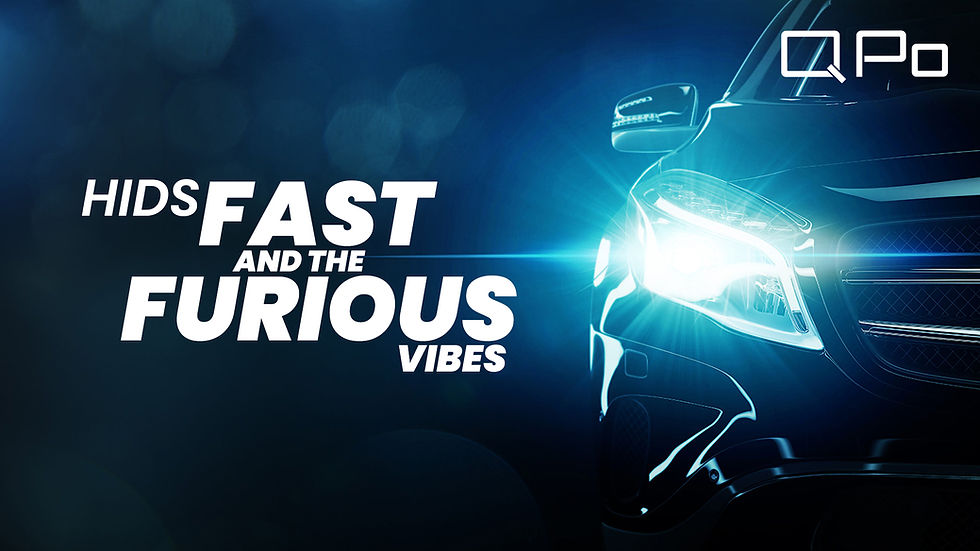Are LED Headlights Worth the Upgrade?: Halogen vs. HID vs. LED
- Q Po India
- Aug 20
- 3 min read

Picture this:
You’re driving home late at night, humming along to your playlist, when suddenly a white beam from the opposite lane hits your eyes harder than your 12th board exam results.
Remember when your dad’s old car had those yellowish halogen bulbs that barely lit up the road?
Fast forward to today: cars now come with LEDs so bright they could land airplanes. And just when you thought it couldn’t get fancier — boom — here come laser headlamps.
Welcome to the Headlamp Wars, where car companies compete not with horsepower, but with how much they can blind the poor guy driving opposite you.
Level 1: The Halogen Era

Halogens were cheap, reliable, and… well, dim. Driving at night meant leaning forward, squinting, and praying no cow decided to cross suddenly. Yeah, that was the halogen struggle.
Relatable Example: If you’ve ever driven a 2005 Alto or WagonR at night, you know the struggle.
Level 2: HIDs — Fast & Furious Vibes

Then came HID lamps — bluish-white, sharp, and totally Bollywood disco. Suddenly, every car looked like it belonged in a street racing gang.
The downside? They took time to “warm up,” cost a bomb, and made people feel cooler than they actually were.
Also, half the time, the blue glare blinded oncoming traffic. Congratulations, you have upgraded from “I can’t see” to “Nobody else can see.”
Level 3: LEDs — “Daylight at Midnight”

Enter LEDs — the headlamp version of Jio Internet. Bright, instant, efficient, and stylish.
They made DRLs (Daytime Running Lamps) a thing — those “angry eyebrow” lights that make your car look like it’s glaring at everyone in traffic.
That moment: Your cousin buys a new SUV, and the first thing he does? Parks it at night, switches on DRLs, and clicks 57 Insta stories captioned “Beast mode ON.”
While aftermarket white lights blind everyone. Enter QPo GLO LED Headlights
The perfect balance of powerful enough to light up the road, yet balanced so you see better without turning traffic into a laser show.
Built for Indian roads, they’re dustproof, waterproof, heat-resistant, and come with a 20,000 RPM cooling fan for durability. Easy plug-and-play installation, 30,000-hour lifespan, and a 1-year warranty make them a smart upgrade.
See better, drive safer, shine smarter. [Shop Now]
Level 4: Laser Lights — “Bro, This is a Bit Much”

Luxury cars now flex with laser headlamps. They’re insanely powerful — like carrying a mini sun in your bonnet.
But here’s the catch: they cost more than an entire used Maruti 800.
Do you really need them for Indian roads?
Unless you’re planning a midnight safari in Ladakh, nah
Misuse Olympics: Blinding Each Other
Let’s be real. No matter how advanced the headlamps get, in India, they end up being used like this:
* High beam in city traffic = our unofficial national pastime.
* Aftermarket white HID kits that can fry your retina.
* Misaligned projectors that light up trees instead of the road.
And of course, the guy who flashes headlights behind you even when you’re stuck at a red light.
Relatable moment: You switch to low beam out of courtesy, the guy opposite doesn’t. You squint, curse, and end up turning yours back to high. Congrats, you just joined the blinding battle royale.
So, Do Brighter Lights Actually Help?
* On highways: Yes. LEDs or projectors make night drives less scary.
* In cities: Nope. They mostly just make everyone hate you.
* In villages: Maybe. They help avoid cows, but also attract every insect within 2 km.
Headlamps have evolved from dim halogens to overkill lasers. But no matter how much tech companies pack in, on Indian roads, the real challenge is not “Can I see?” but “Will others let me see?”
So next time you get blinded by an SUV with its high beams on, just smile and think: This is not light. This is ego on full brightness.



Comments